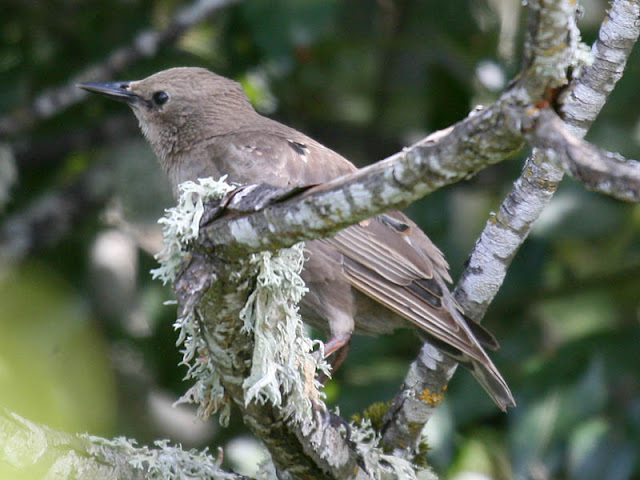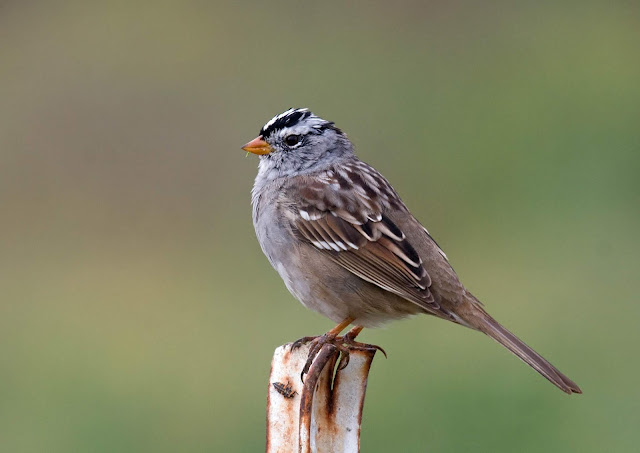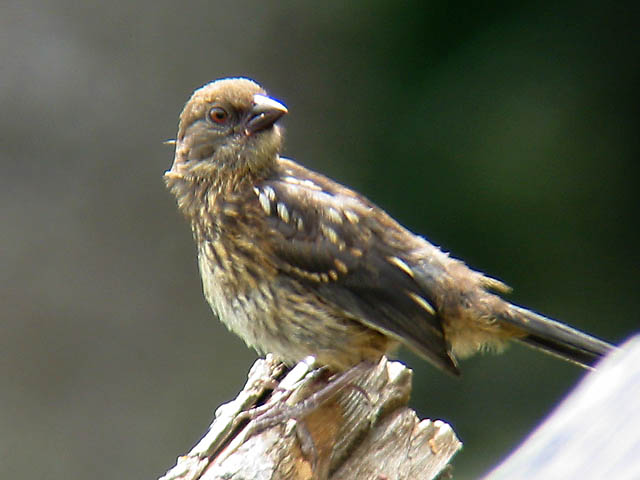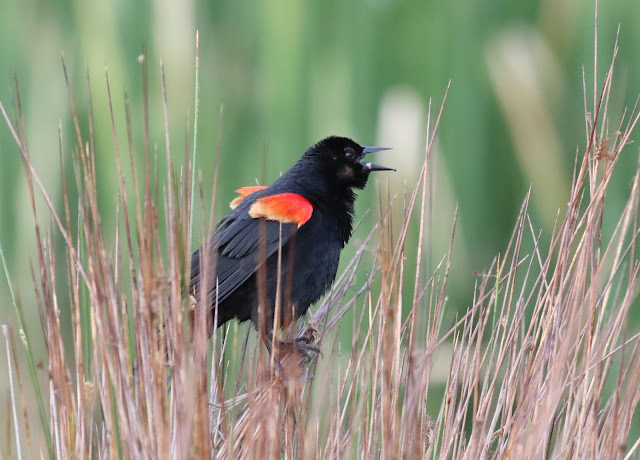This series started with
The 10 most common backyard birds of San Diego, California. It was followed by
Another 10 common backyard birds of San Diego.
Here, then, are a final 10 common birds you will likely be able to find in your backyard. Of course, depending upon what trees and plants you have, what habitats border your home, and exactly where you live, many more are possible--especially during spring and fall migration. And if you include the airspace above your home, then you may spot even more as they fly over. But these final ten are likely in most backyards within the region.
Combined with the previous 20 species, these 30 total common birds will provide the beginner with a manageable starting point for learning the backyard birds of San Diego and, indeed, most of southern California.
So let's get right to it. Here are more birds to find in your backyard in the San Diego region.
21) European Starling
 |
| Adult European Starling. Escondido, California. January 14, 2018. |
 |
| Juvenile European Starling. Forest Grove, Oregon. August 18, 2007. |
Introduced to North America in the late 19th century, European Starlings are pretty much resident across North America from southern Canada to northern Mexico in rural and urban areas. Because of their aggressive behavior most birders do not want starlings in their backyards. Don't feed birds human food scraps and you likely won't have many European Starlings. Otherwise they may take over your feeders.
22) White-crowned Sparrow
 |
| Adult White-crowned Sparrow. Poway, California. April 8, 2018. |
 |
| Immature White-crowned Sparrow. Lake Hodges, California. December 14, 2014. |
White-crowned Sparrows from northern areas are common from October to April in southern California. They should come to your tray feeders or feed on the ground under them. They sing a cheerful series of notes and trills in late winter and on their northward journey in spring to their breeding grounds.
23) Bewick's Wren
 |
| Bewick's Wren. Palomar Mountain. September 5, 2016. |
A jumble of notes and a trill. The song of this insect-eating bird is similar to Song Sparrow, which may be found in similar brushy habitats. These birds are resident--not migrating-- and may breed in your backyard if provided with a nest box.
24) Spotted Towhee
 |
| Adult Spotted Towhee. Julian, California. November 4, 2018. |
 |
| Juvenile Spotted towhee. Hagg Lake, Oregon. July 10, 2004. |
Spotted Towhees are birds of chaparral in southern California. The more brushy the ground and taller the hedges, the more likely a family of these birds will be resident in your yard. They will feed on the ground under your feeder, kicking up leaves to search for grubs and seed. They even use this kicking feeding technique on your tray feeder--scattering seed everywhere!
25) Cliff Swallow
 |
| Cliff Swallow. Malheur NWR, Oregon. May 28, 2013. |
These insect-eating birds arrive in spring and leave for the winter. They build their gourd-shaped mud nests along out-building rafters, under the eaves of barns, on cliffs, or under highway overpasses, sometimes in large numbers. You may see them flying high over your backyard hunting flying insects, especially if there is open fresh water nearby.
26) Song Sparrow
 |
| Song Sparrow. Vista, California. November 24, 2017. |
The resident seed-eating Song Sparrow is spread widely through many habitats where brush and water are found. It loves ponds, wet thickets, roadside ditches, and mature residential landscaped hedges. A pair may be attracted to the seed in your backyard feeder.
27) Rock Pigeon (Feral Pigeon)
 |
| Rock Pigeon. La Jolla, California. July 24, 2016. |
People have brought pigeons with them wherever they go, it seems. They nest "in the wild" on city building ledges and other situations, but many you see flying around are probably raised locally.
28) Red-winged Blackbird
 |
| Male Red-winged Blackbird. Palomar Mountain, California. June 17, 2018. |
 |
| Female Red-winged Blackbird. Escondido, California. March 25, 2018. |
In winter these blackbirds may visit your sunflower feeders,... or shopping mall parking lot. But during most of the year you'll need to visit cattail marshes or lake shores to find these birds. The females and juvenile birds are striped like sparrows and can fool beginners.
29) White-throated Swift
 |
| White-throated Swift. Lake Wohlford, California. November 11, 2018. |
Historically nesting in craggy cliffs, you may find these sleek speed-demons most-reliably in summer as they nest in the drain holes on the undersides of highway overpasses. Their feet are weak, so they don't perch on wires or in trees as swallows. No doubt there are some flying over your house chasing flying insects... way, way up high!
30) Allen's Hummingbird
 |
| Male Allen's Hummingbird. Oceanside, California. February 22, 2015. |
 |
| Female Allen's Hummingbird. Imperial Beach, California. July 29, 2018. |
Formerly a summer visitor to the California coastal regions (arriving in January and departing by July), more and more are remaining year-round in the southern California lowlands--especially in lagoons and parks near the beach. If you are 10-30 miles inland from the coast, these birds may visit your hummingbird feeders in spring. If you live within 10 miles of the ocean, you may have these birds year-round from Los Angeles southward. Even in their preferred habitats, the larger Anna's Hummingbird is probably more common.
That's it then. Can you find all these birds from your southern California yard? Which ones haven't you seen? What other species are regular in your yard? What's your favorite backyard bird?
















Thank you for your reply on the other post. Yep! a hooded oriole it was in my Del Cerro yard. I'm inspired to find all 30 birds of your series. Maybe I'll print it and use it like a bingo card. Hah! :) Thank you for your generosity teaching us about San Diego birds. Oh, funny thing, when I was a kid growing up in Alpine the big blue California Scrub Jays would come by and steal the large dog kibble one by one from our dog's bowl on our covered deck. Reading your description, that behavior makes perfect sense now as they were probably hiding the kibble somewhere else.
ReplyDeleteHmm... a game card. That'd be great. 5 in a row and you win! Start over each week. Maybe with fridge magnets?
DeleteTwo questions. Aren't the more common black birds in San Diego Ravens? They look too big to be Crows. Also, what are the birds that have an orange stripe on the back of their heads?
ReplyDeleteI was surprised how common the Ravens are in San Diego--even downtown! However, Crows are at least 3 times more common. They are both quite common. And the ravens in this area seem on the small size and have a less deep voice than those in the mountains and desert just 40 miles to the east.
DeleteThe wedge-tail, heavier bill, and deeper voice separates ravens. Crows "row" with their wings in flight, rather steady, continuous flapping. Ravens tend to soar on flat wings and pause more in flight.
Not sure about the other bird. Two woodpeckers, Northern Flicker and Nuttall's Woodpeckers have males with red on the nape. Nothing else comes to mind at the moment.